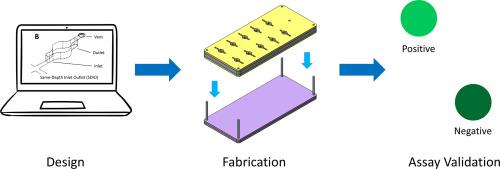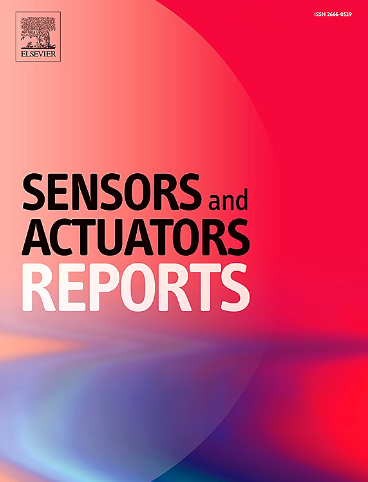核酸扩增用低成本微流体的设计、制造和净化
IF 7.6
Q1 BIOTECHNOLOGY & APPLIED MICROBIOLOGY
引用次数: 0
摘要
液体检测,如聚合酶链反应(PCR)和环介导等温扩增(LAMP),很难在即时微流体设备中实现,因为气泡经常形成。我们提出了一种称为同深入口出口(SDIO)的反应室设计,与传统设计相比,发现在不同流速下,气泡形成的实例平均减少了92.2%。我们设计的制造工艺使用了激光切割机,激光切割机和层压技术,使快速和低成本的原型。评估了核酸酶污染的制造方法,并详细介绍了在芯片组装期间和组装后减少核酸酶的最佳做法。我们的技术,使用乙醇冲洗和紫外线- c光辐射的组合,被发现减少RNases高达十倍。不同材料的微流控兼容性测试与LAMP分析试剂,使芯片逼真地模拟最终表面积和体积。不同胶粘剂的性能存在差异,其中正负反应之间的最佳荧光比为4.63。我们的微流控设计通过在反应室中扩增带有SARS-CoV-2引物的加标RT-LAMP试验来验证。总体研究结果旨在促进微流体装置的早期开发和原型设计,并提供一致和可靠的结果。本文章由计算机程序翻译,如有差异,请以英文原文为准。

Design, fabrication, and decontamination of low-cost microfluidics for nucleic acid amplification
Liquid assays, such as polymerase chain reaction (PCR) and loop-mediated isothermal amplification (LAMP), are difficult to implement in point-of-care microfluidic devices because bubbles often form. We present a reaction chamber design called same-depth inlet outlet (SDIO), which was found to reduce the instances of bubble formation by an average of 92.2 % across different flow rates when compared to traditional designs. We designed the fabrication process using xurography, laser cutting, and lamination techniques, which enable rapid and low-cost prototyping. The fabrication methods were evaluated for nuclease contamination, and best practices to reduce nucleases during and after chip assembly are detailed. Our technique, using a combination of ethanol rinses and ultraviolet-C light radiation, was found to reduce RNases up to tenfold. Different materials were tested for microfluidic compatibility with LAMP assay reagents by making chips that realistically emulate final surface areas and volumes. A variation in performance was found among different adhesives, where the best fluorescence ratio between positive and negative reactions was 4.63. Our microfluidic design was validated by amplifying a spiked RT-LAMP assay with SARS-CoV-2 primers in the reaction chambers. The overall findings aim to facilitate early-stage development and prototyping of microfluidic devices with consistent and reliable results.
求助全文
通过发布文献求助,成功后即可免费获取论文全文。
去求助
来源期刊

Sensors and Actuators Reports
Multiple-
CiteScore
9.60
自引率
0.00%
发文量
60
审稿时长
49 days
期刊介绍:
Sensors and Actuators Reports is a peer-reviewed open access journal launched out from the Sensors and Actuators journal family. Sensors and Actuators Reports is dedicated to publishing new and original works in the field of all type of sensors and actuators, including bio-, chemical-, physical-, and nano- sensors and actuators, which demonstrates significant progress beyond the current state of the art. The journal regularly publishes original research papers, reviews, and short communications.
For research papers and short communications, the journal aims to publish the new and original work supported by experimental results and as such purely theoretical works are not accepted.
 求助内容:
求助内容: 应助结果提醒方式:
应助结果提醒方式:


